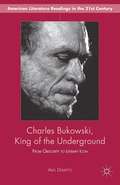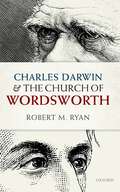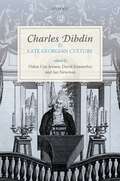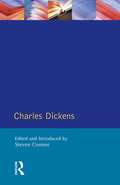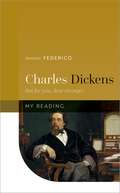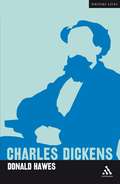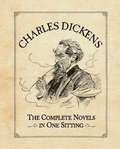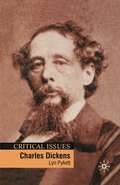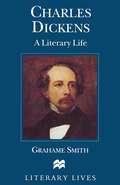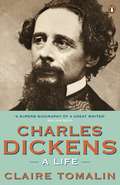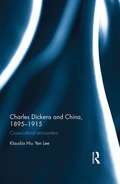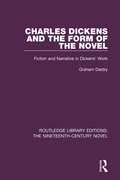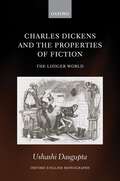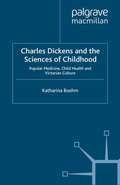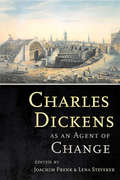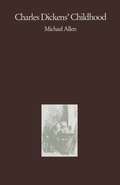- Table View
- List View
Charles Bukowski, King of the Underground: From Obscurity to Literary Icon (American Literature Readings in the 21st Century)
by A. DebrittoThis critical study of the literary magazines, underground newspapers, and small press publications that had an impact on Charles Bukowski's early career, draws on archives, privately held unpublished Bukowski work, and interviews to shed new light on the ways in which Bukowski became an icon in the alternative literary scene in the 1960s.
Charles Darwin and the Church of Wordsworth (Oxford English Monographs)
by Robert M. RyanCharles Darwin and the Church of William Wordsworth is a study of the cultural connections between two of the nineteenth century's most influential figures, Charles Darwin and William Wordsworth. When Darwin presented On the Origin of Species, his reading public's affective response to the natural world had already been profoundly influenced by William Wordsworth. Wordsworth presented nature as benign, harmonious, a source of moral inspiration and spiritual blessing, and a medium through which one might enter into communion with the Divine. Long after his death, he continued to be revered throughout the English-speaking world, not only as a great poet, but as a theologian with a broader following than any prelate and an appeal that transcended or ignored sectarian differences. For believers and sceptics alike, Wordsworth's poetry offered a readily accessible and intellectually respectable counterweight to Darwin's vision of a material universe evolving by fixed laws in which Divinity played no discernible role and where concepts like beauty and harmony were material conditions to be explained in scientific terms. Wordsworth's theology of nature became for many readers a more effective counterforce to Darwin's ideas than Biblical orthodoxy, but it also provided an enriching context for the reception of evolutionary theory, aiding theists in their effort to reach an accommodation with the new science. As the nineteenth century's two most prominent theoreticians of nature's life, Wordsworth and Darwin competed for attention among those seeking to understand humanity's relationship with the natural world, and their disciples engaged in a productive, mutually transformative dialogue in which the poet's cultural authority influenced the way Darwin was received, and Darwinian science adjusted interpretation and evaluation of the poetry. Charles Darwin and the Church of William Wordsworth explores the broad cultural relationship between Wordsworth, Darwin, and their disciples, contextualising them within wider discussions about the relationship between religion and science in the nineteenth century.
Charles Dibdin and Late Georgian Culture
by Ian Newman Oskar Cox Jensen David KennerleyCharles Dibdin (1745-1814) was one of the most popular and influential creative forces in late Georgian Britain, producing a diversity of works that defy simple categorisation. He was an actor, lyricist, composer, singer-songwriter, comedian, theatre-manager, journalist, artist, music tutor, speculator, and author of novels, historical works, polemical pamphlets, and guides to musical education. This collection of essays illuminates the social and cultural conditions that made such a varied career possible, offering fresh insights into previously unexplored aspects of late Georgian culture, society, and politics. Tracing the transitions in the cultural economy from an eighteenth-century system of miscellany to a nineteenth-century regime of specialisation, Charles Dibdin and Late Georgian Culture illustrates the variety of Dibdin's cultural output as characteristic of late eighteenth-century entertainment, while also addressing the challenge mounted by a growing preoccupation with specialisation in the early nineteenth century. The chapters, written by some of the leading experts in their individual disciplines, examine Dibdin's extraordinarily wide-ranging career, spanning cultural spaces from the theatres at Drury Lane and Covent Garden, through Ranelagh Gardens, Sadler's Wells, and the Royal Circus, to singing on board ships and in elegant Regency parlours; from broadside ballads and graphic satires, to newspaper journalism, mezzotint etchings, painting, and decorative pottery. Together they demonstrate connections between forms of cultural production that have often been treated as distinct, and provide a model for a more integrated approach to the fabric of late Georgian cultural production.
Charles Dibdin and Late Georgian Culture
Charles Dibdin (1745-1814) was one of the most popular and influential creative forces in late Georgian Britain, producing a diversity of works that defy simple categorisation. He was an actor, lyricist, composer, singer-songwriter, comedian, theatre-manager, journalist, artist, music tutor, speculator, and author of novels, historical works, polemical pamphlets, and guides to musical education. This collection of essays illuminates the social and cultural conditions that made such a varied career possible, offering fresh insights into previously unexplored aspects of late Georgian culture, society, and politics. Tracing the transitions in the cultural economy from an eighteenth-century system of miscellany to a nineteenth-century regime of specialisation, Charles Dibdin and Late Georgian Culture illustrates the variety of Dibdin's cultural output as characteristic of late eighteenth-century entertainment, while also addressing the challenge mounted by a growing preoccupation with specialisation in the early nineteenth century. The chapters, written by some of the leading experts in their individual disciplines, examine Dibdin's extraordinarily wide-ranging career, spanning cultural spaces from the theatres at Drury Lane and Covent Garden, through Ranelagh Gardens, Sadler's Wells, and the Royal Circus, to singing on board ships and in elegant Regency parlours; from broadside ballads and graphic satires, to newspaper journalism, mezzotint etchings, painting, and decorative pottery. Together they demonstrate connections between forms of cultural production that have often been treated as distinct, and provide a model for a more integrated approach to the fabric of late Georgian cultural production.
Charles Dickens
by Steven ConnorDickens is second only to Shakespeare in the range and intensity of critical discussion which his work has provoked. His writing is central to literature and culture across the English-speaking world. In this important new anthology, Steven Connor gathers together representative examples of the range of new critical approaches to Dickens over the last two decades.
Charles Dickens
by Steven ConnorDickens is second only to Shakespeare in the range and intensity of critical discussion which his work has provoked. His writing is central to literature and culture across the English-speaking world. In this important new anthology, Steven Connor gathers together representative examples of the range of new critical approaches to Dickens over the last two decades.
Charles Dickens: But for you, dear stranger (My Reading)
by Annette FedericoA personal approach to Dickens's art that pays attention to what magnetizes Federico or strikes her as newly relevant to our own world, and to her life, as she explores what Dickens' works are emotionally about. Dickens's first concern in all his fiction is with people's feelings and their imaginations. Everything else—the social criticism, the satire, the comedy—flows from that spring. How does a person begin to imagine, to enter vividly into the life he or she has been given, and into the lives of others? How does someone change, how do they love, give their trust, look forward to the future? These questions make their way into all of Dickens's novels, including the four discussed in this contribution to the My Reading series: Oliver Twist (1837-39), David Copperfield (1849-50), Little Dorrit (1855-57), and A Tale of Two Cities (1859). Consistent with the aims of the series, this book takes a personal approach to Dickens's art. Federico follows her own responses, paying attention to what magnetizes her or strikes her as newly relevant to our own world, and to her life. What is the story emotionally about? This becomes the important question as she reads through Dickens's works. It is the question that opens the door to her own memories, her own stories, as she grows from being an innocent reader of Dickens to a more critical, professionalized one—while still listening confidentially to what Dickens has to teach her about hope, love, and the limits of knowledge.
Charles Dickens: But for you, dear stranger (My Reading)
by Annette FedericoA personal approach to Dickens's art that pays attention to what magnetizes Federico or strikes her as newly relevant to our own world, and to her life, as she explores what Dickens' works are emotionally about. Dickens's first concern in all his fiction is with people's feelings and their imaginations. Everything else—the social criticism, the satire, the comedy—flows from that spring. How does a person begin to imagine, to enter vividly into the life he or she has been given, and into the lives of others? How does someone change, how do they love, give their trust, look forward to the future? These questions make their way into all of Dickens's novels, including the four discussed in this contribution to the My Reading series: Oliver Twist (1837-39), David Copperfield (1849-50), Little Dorrit (1855-57), and A Tale of Two Cities (1859). Consistent with the aims of the series, this book takes a personal approach to Dickens's art. Federico follows her own responses, paying attention to what magnetizes her or strikes her as newly relevant to our own world, and to her life. What is the story emotionally about? This becomes the important question as she reads through Dickens's works. It is the question that opens the door to her own memories, her own stories, as she grows from being an innocent reader of Dickens to a more critical, professionalized one—while still listening confidentially to what Dickens has to teach her about hope, love, and the limits of knowledge.
Charles Dickens (Writers Lives)
by Donald HawesCharles Dickens is without doubt a literary giant. The most widely read author of his own generation, his works remain incredibly popular and important today. Often seen as the quintessential Victorian novelist, his texts convey perhaps better than any others the drive for wealth and progress and the social contrasts that characterised the Victorian era. His works are widely studied throughout the world both as literary masterpieces and as classic examples of the nineteenth century novel. Combining a biographical approach with close reading of the novels, Donald Hawes offers an illuminating portrait of Dickens as a writer and insight into his life and times. This book will provide a short, lively but sophisticated introduction to Dickens's work and the personal and social context in which it was written.
Charles Dickens (Writers Lives)
by Donald HawesCharles Dickens is without doubt a literary giant. The most widely read author of his own generation, his works remain incredibly popular and important today. Often seen as the quintessential Victorian novelist, his texts convey perhaps better than any others the drive for wealth and progress and the social contrasts that characterised the Victorian era. His works are widely studied throughout the world both as literary masterpieces and as classic examples of the nineteenth century novel. Combining a biographical approach with close reading of the novels, Donald Hawes offers an illuminating portrait of Dickens as a writer and insight into his life and times. This book will provide a short, lively but sophisticated introduction to Dickens's work and the personal and social context in which it was written.
Charles Dickens: The Complete Novels in One Sitting (RP Minis)
by Joelle HerrCelebrate the bicentennial birthday of Charles Dickens with this Miniature Edition packed with witty summaries of the novels of one of history's most beloved storytellers. All fans of great literature can enjoy these perfectly portable renditions of Oliver Twist, A Christmas Carol, Great Expectations, A Tale of Two Cities, and all the Dickensian classics. Featuring synopses, character profiles, and illustrations, this mini book brings to life twenty classic tales and the iconic characters that populate the world of Dickens.
Charles Dickens: The Complete Novels in One Sitting (RP Minis)
by Joelle HerrCelebrate the bicentennial birthday of Charles Dickens with this Miniature Edition packed with witty summaries of the novels of one of history's most beloved storytellers. All fans of great literature can enjoy these perfectly portable renditions of Oliver Twist, A Christmas Carol, Great Expectations, A Tale of Two Cities, and all the Dickensian classics. Featuring synopses, character profiles, and illustrations, this mini book brings to life twenty classic tales and the iconic characters that populate the world of Dickens.
Charles Dickens (Critical Issues)
by Lyn PykettTo many of his contemporaries, Charles Dickens was the greatest writer of his age; a one-man fiction industry who produced fourteen massive novels, and numerous sketches, essays and stories, many of which appeared in the two magazines which he founded and edited. Today the work of one of the first and most successful mass-circulation authors continues to enthrall readers around the world.This wide-ranging book examines the writings of Dickens, not only in his time but also in ours. it looks at the author as a Victorian 'man of letters', and explores his cultural and critical impact both on the definition of the novel in the nineteenth century and the subsequent development of the form in the twentieth. Lyn Pykett focuses on Dickens as journalist, literary entrepreneur, the conductor of magazines, the shaper of the serial novel, the manipulator of the multiple plot, and the creator of eccentric characters. She also assesses the modernity of the writer's alienated protagonists and their social environments, as well as reassessing his representations of the vivid, bleak and at times menacing spectacle of the metropolis, from the late modern/postmodern perspective of the twenty first century.Each chapter of this text analyses the work of a particular decade in Dickens's career, providing a lively contextual study which places his writings in relation to the worlds that made him, and the literary worlds which he made. It is essential reading for all those with an interest in one of the most popular, and enduring, British novelists of all time.
Charles Dickens (Critical Issues)
by Lyn PykettTo many of his contemporaries, Charles Dickens was the greatest writer of his age; a one-man fiction industry who produced fourteen massive novels, and numerous sketches, essays and stories, many of which appeared in the two magazines which he founded and edited. Today the work of one of the first and most successful mass-circulation authors continues to enthrall readers around the world.This wide-ranging book examines the writings of Dickens, not only in his time but also in ours. It looks at the author as a Victorian 'man of letters', and explores his cultural and critical impact both on the definition of the novel in the nineteenth century and the subsequent development of the form in the twentieth. Lyn Pykett focuses on Dickens as journalist, literary entrepreneur, the conductor of magazines, the shaper of the serial novel, the manipulator of the multiple plot, and the creator of eccentric characters. She also assesses the modernity of the writer's alienated protagonists and their social environments, as well as reassessing his representations of the vivid, bleak and at times menacing spectacle of the metropolis, from the late modern/postmodern perspective of the twenty first century.Each chapter of this text analyses the work of a particular decade in Dickens's career, providing a lively contextual study which places his writings in relation to the worlds that made him, and the literary worlds which he made. It is essential reading for all those with an interest in one of the most popular, and enduring, British novelists of all time.
Charles Dickens: A Literary Life (Literary Lives)
by Grahame SmithThis study of Dickens's career as a professional writer uses a range of material to describe and analyze the ways in which his work can be seen as a form of literary production. It thus offers a challenge to traditional accounts which stress the private nature of Dickens's genius. Smith focuses on the communal nature of Dickens's achievement in his struggles with publishers, the expectations of a vast public, and the demands of serialization.
Charles Dickens: A Life
by Claire TomalinCharles Dickens is the acclaimed definitive biography by bestselling author Claire Tomalin Charles Dickens was a phenomenon: a demonicly hardworking journalist, the father of ten children, a tireless walker and traveller, a supporter of liberal social causes, but most of all a great novelist - the creator of characters who live immortally in the English imagination: the Artful Dodger, Mr Pickwick, Pip, David Copperfield, Little Nell, Lady Dedlock, and many more.At the age of twelve he was sent to work in a blacking factory by his affectionate but feckless parents. From these unpromising beginnings, he rose to scale all the social and literary heights, entirely through his own efforts. When he died, the world mourned, and he was buried - against his wishes - in Westminster Abbey.Yet the brilliance concealed a divided character: a republican, he disliked America; sentimental about the family in his writings, he took up passionately with a young actress; usually generous, he cut off his impecunious children. From the award-winning author of Samuel Pepys, Charles Dickens: A Life paints an unforgettable portrait of Dickens, capturing brilliantly the complex character of this great genius. If you loved Great Expectations, Oliver Twist and A Christmas Carol, this book is invaluable reading.'By far the most humane and imaginatively sympathetic account yet for the general reader' Amanda Craig, New StatesmanClaire Tomalin is the award-winning author of eight highly acclaimed biographies, including: The Life and Death of Mary Wollstonecraft; Shelley and His World; Katherine Mansfield: A Secret Life; The Invisible Woman: The Story of Nelly Ternan and Charles Dickens; Mrs Jordan's Profession; Jane Austen: A Life; Samuel Pepys: The Unequalled Self; Thomas Hardy: The Time-Torn Man and, most recently, Charles Dickens: A Life. A former literary editor of the New Statesman and the Sunday Times, she is married to the playwright and novelist Michael Frayn.
Charles Dickens and China, 1895-1915: Cross-Cultural Encounters
by Klaudia Hiu LeeFrom 1895 to 1915, Chinese translations of Dickens's fiction first appeared as part of a growing interest in Western literature and culture among Chinese intellectuals. Klaudia Hiu Yen investigates the multifarious ways in which Dickens’s works were adapted, reconfigured, and transformed for the Chinese readership against the turbulent political and social conditions in the last stages of the Qing dynasty (1644-1912) and the early Republic (1912-1949). Moving beyond the 'Response to the West’ model which often characterises East-West interactions, Lee explores how Chinese intellectuals viewed Dickens’s novels as performing a particular social function; on occasion, they were used to advance the country’s social and political causes. Translation and adaptation became a means through which the politics and social values of the original Dickens texts were undermined or even subverted. Situating the early introduction of Dickens to China within the broader field of Victorian studies, Lee challenges some of the theoretical and conceptual underpinnings of the ’global’ turn, both in Dickens scholarship and in Victorian studies in general.
Charles Dickens and China, 1895-1915: Cross-Cultural Encounters
by Klaudia Hiu LeeFrom 1895 to 1915, Chinese translations of Dickens's fiction first appeared as part of a growing interest in Western literature and culture among Chinese intellectuals. Klaudia Hiu Yen investigates the multifarious ways in which Dickens’s works were adapted, reconfigured, and transformed for the Chinese readership against the turbulent political and social conditions in the last stages of the Qing dynasty (1644-1912) and the early Republic (1912-1949). Moving beyond the 'Response to the West’ model which often characterises East-West interactions, Lee explores how Chinese intellectuals viewed Dickens’s novels as performing a particular social function; on occasion, they were used to advance the country’s social and political causes. Translation and adaptation became a means through which the politics and social values of the original Dickens texts were undermined or even subverted. Situating the early introduction of Dickens to China within the broader field of Victorian studies, Lee challenges some of the theoretical and conceptual underpinnings of the ’global’ turn, both in Dickens scholarship and in Victorian studies in general.
Charles Dickens and the Form of the Novel: Fiction and Narrative in Dickens' Work (Routledge Library Editions: The Nineteenth-Century Novel)
by Graham DaldryFirst published in 1987. While there have been commentaries on his humour, his seriousness, his social concerns, and other specific aspects of his work such accounts have only tended to divide our understanding of the novels, to lead us to see them as failures of artistic unity. In this book the author seeks to address this question of unity and find a terminology that can treat language, plot and representation of reality as a coherent imaginative effort. This thesis is worked out in detail with reference to several of the novels, and represents a challenging re-evaluation Dickens’ achievement as a novelist. This book will be if interest to student of literature.
Charles Dickens and the Form of the Novel: Fiction and Narrative in Dickens' Work (Routledge Library Editions: The Nineteenth-Century Novel)
by Graham DaldryFirst published in 1987. While there have been commentaries on his humour, his seriousness, his social concerns, and other specific aspects of his work such accounts have only tended to divide our understanding of the novels, to lead us to see them as failures of artistic unity. In this book the author seeks to address this question of unity and find a terminology that can treat language, plot and representation of reality as a coherent imaginative effort. This thesis is worked out in detail with reference to several of the novels, and represents a challenging re-evaluation Dickens’ achievement as a novelist. This book will be if interest to student of literature.
Charles Dickens and the Properties of Fiction: The Lodger World (Oxford English Monographs)
by Ushashi DasguptaWhen Dickens was nineteen years old, he wrote a poem for Maria Beadnell, the young woman he wished to marry. The poem imagined Maria as a welcoming landlady offering lodgings to let. Almost forty years later, Dickens died, leaving his final novel unfinished - in its last scene, another landlady sets breakfast down for her enigmatic lodger. These kinds of characters are everywhere in Dickens's writing. Charles Dickens and the Properties of Fiction: The Lodger World explores the significance of tenancy in his fiction. In nineteenth century Britain the vast majority of people rented, rather than owned, their homes. Instead of keeping to themselves, they shared space - renting, lodging, taking lodgers in, or simply living side-by-side in a crowded modern city. Charles Dickens explored both the chaos and the unexpected harmony to be found in rented spaces, the loneliness and sociability, the interactions between cohabitants, the complex gender dynamics at play, and the relationship between space and money. Charles Dickens and the Properties of Fiction demonstrates that a cosy, secluded home life was beyond the reach of most Victorian Londoners, and considers Dickens's nuanced conception of domesticity. Tenancy maintained an enduring hold upon his imagination, giving him new stories to tell and offering him a set of models to think about authorship. He celebrated the fact that unassuming houses brim with narrative potential: comedies, romances, and detective plots take place behind their doors. Charles Dickens and the Properties of Fiction: The Lodger World wedges these doors open.
Charles Dickens and the Properties of Fiction: The Lodger World (Oxford English Monographs)
by Ushashi DasguptaWhen Dickens was nineteen years old, he wrote a poem for Maria Beadnell, the young woman he wished to marry. The poem imagined Maria as a welcoming landlady offering lodgings to let. Almost forty years later, Dickens died, leaving his final novel unfinished - in its last scene, another landlady sets breakfast down for her enigmatic lodger. These kinds of characters are everywhere in Dickens's writing. Charles Dickens and the Properties of Fiction: The Lodger World explores the significance of tenancy in his fiction. In nineteenth century Britain the vast majority of people rented, rather than owned, their homes. Instead of keeping to themselves, they shared space - renting, lodging, taking lodgers in, or simply living side-by-side in a crowded modern city. Charles Dickens explored both the chaos and the unexpected harmony to be found in rented spaces, the loneliness and sociability, the interactions between cohabitants, the complex gender dynamics at play, and the relationship between space and money. Charles Dickens and the Properties of Fiction demonstrates that a cosy, secluded home life was beyond the reach of most Victorian Londoners, and considers Dickens's nuanced conception of domesticity. Tenancy maintained an enduring hold upon his imagination, giving him new stories to tell and offering him a set of models to think about authorship. He celebrated the fact that unassuming houses brim with narrative potential: comedies, romances, and detective plots take place behind their doors. Charles Dickens and the Properties of Fiction: The Lodger World wedges these doors open.
Charles Dickens and the Sciences of Childhood: Popular Medicine, Child Health and Victorian Culture (Palgrave Studies in Nineteenth-Century Writing and Culture)
by K. BoehmThis book takes a fresh look at childhood in Dickens' works and in Victorian science and culture more generally. It offers a new way of understanding Dickens' interest in childhood by showing how his fascination with new scientific ideas about childhood and practices of scientific inquiry shaped his narrative techniques and aesthetic imagination.
Charles Dickens as an Agent of Change
Sixteen scholars from across the globe come together in Charles Dickens as an Agent of Change to show how Dickens was (and still is) the consummate change agent. His works, bursting with restless energy in the Inimitable's protean style, registered and commented on the ongoing changes in the Victorian world while the Victorians' fictional and factional worlds kept (and keep) changing. The essays from notable Dickens scholars—Malcolm Andrews, Matthias Bauer, Joel J. Brattin, Doris Feldmann, Herbert Foltinek, Robert Heaman, Michael Hollington, Bert Hornback, Norbert Lennartz, Chris Louttit, Jerome Meckier, Nancy Aycock Metz, David Paroissien, Christopher Pittard, and Robert Tracy—suggest the many ways in which the notion of change has found entry into and is negotiated in Dickens' works through four aspects: social change, political and ideological change, literary change, and cultural change. An afterword by the late Edgar Rosenberg adds a personal account of how Dickens changed the life of one eminent Dickensian.
